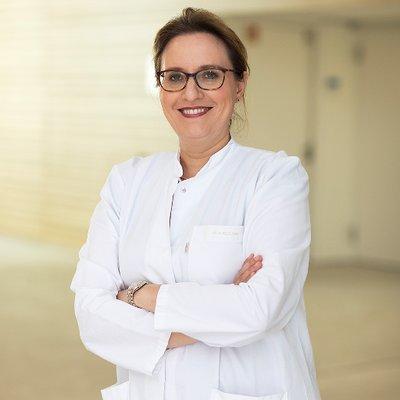The Benefits of Particle Therapy in Cancer Treatment - Lecture by Prof. Stephanie E. Combs#
Academia Europaea and the Horizons lecture series
#
20 February 2019, Auditorium 1, Realfagbygget (Allegaten 41), University of Bergen
Event website

Norway is establishing particle therapy centres for cancer treatment in Oslo and Bergen. Particle therapy, in combination with molecular and digital biomarkers is revolutionizing cancer treatment. A world leading expert will present recent research and technology developements. #
The Lecture (held in English)#
Professor Stephanie Combs will give a lecture on The Benefits of Particle Therapy: Individualized concepts based on biology, physics and prospective clinical trials.
External beam radiation therapy as the most conventional form of radiotherapy where the radiation is delivered to a particular part of the body from the outside, is a crucial component of modern oncology. Depending on the type of tumor, radiation therapy (RT) is either an essential complementary and supportive treatment before or after surgery or a clear treatment alternative to surgery. Early treatments were performed with photon radiotherapy. The photons cause damage to the cancer cell’s DNA, so the cancerous cells reproduce more slowly or die. Initially X-ray or clinical localization was used to confine the space for irradiation before a more precise photon RT with 3D-conformal planning became possible after the introduction of computed tomography (CT) and magnetic resonance imaging (MRI).
The next step was the development of stereotactic RT, where the benefits of detailed imaging scans and patient immobilization developed by neurosurgery allowed a very precise targeted irradiation, mostly for tumors in the brain or spine. Further technological advances for planning radiation therapy, including intensity modulated RT have made RT even more precise. This method spares normal brain tissue and hence lowers the risk for side effects, especially for lesions that have complex shapes or are close to neighboring healthy organs.
Today, particle therapy with protons or heavier ions opens new horizons in radiation oncology. In comparison to photon RT, particle beams have specific physical and biological properties. Studies have shown that precision can be increased and the biological effect on the cancerous cells is two to three times higher. This leads to fewer side effects and enhances local control of tumors and thus survival. Clinical trials are currently underway to characterize the potential of particle beams. In Europe, the number of particle therapy centers is continuously increasing which stresses the importance of this technique for patient care and research.
These developments, in combination with molecular and digital biomarkers, have the potential to revolutionize radiation oncology and pave the way to personalized medicine.
The lecture is organized by The Horizons Lecture Series and Academia Europaea.
The lecture starts at 16.15, on Wednesday February 20th in Auditorium 1, Realfagbygget (Allegaten 41). Everybody is welcome! Refreshments will be served from 15.45.
Find the event on Facebook .
.
Stephanie E. Combs#
Stephanie E. Combs is Professor and Chair of the Department of Radiation Oncology at the Technical University of Munich (TUM), Munich, Germany, since 2014. Before, she was Vice Chair of the Department of Radiation Oncology in Heidelberg, Germany.
She also holds the position as Director of the Institute of Innovative Radiotherapy (iRT), Department of Radiation Sciences (DRS), at the Helmholtz Zentrum München (HMGU). Prof. Combs is Chair of the Oncological Center (Onkologisches Zentrum) at TUM, and Vice Chair of the Tumor Center Munich (Tumozentrum München, TZM).
Prof. Combs completed Medical School at the Ruprecht-Karls-University in Heidelberg, Germany, Eastern Virginia Medical School (EVMS) in Norfolk, Virginia, and University of Texas Health Science Center at San Antonio (UTHSCSA), San Antonio, Texas. She earned her Doctorate Degree with preclinical work in field of Neuroanatomy, were she studied the development of the sympathoadrenal system and the impact of growth factors on development and formation of the neuronal and non-neuronal networks.
She was trained as a radiation oncologist in Heidelberg, where she specialized in high-precision radiotherapy such as radiosurgery, stereotactic treatments, Intensity Modulated Radiotherapy (IMRT) as well as particle therapy. Her special interest is treatment individualization and optimization of patients with brain tumors and tumors of the skull base, gastrointestinal malignancies as well as childhood cancer. She has set up and conducted over 20 clinical trials, and published over 175 original peer-reviewed articles. Prof. Combs is a member of the German and European Radiation Oncology Societies (DEGRO and ESTRO), the American Society of Radiation Oncology (ASTRO). She is serving as a board member of the Neurooncological Working Group of the German Cancer Society (DKG).
Combs has received numerous honours and awards including the Robert Janker Award for Palliative Care for the study “Generation and Validation of a Prognostic Score to Predict Outcome after Re-Irradiation of Recurrent Glioma”; the Award of the Behnken-Berger-Foundation (Berlin) for “Scientific Research on Carbon Ion Radiotherapy“; the Hermann Holthusen Award of the German Society for Radiation Oncology (DEGRO, 2010) for the work on “Preclinical and clinical research for the optimization of radiotherapeutic treatment of patients with malignant gliomas; the Olympia Morata Research Funding of the Medical Faculty of the Ruprecht-Karls-University Heidelberg on the topic: Treatment optimization of malignant gliomas with carbon ion radiotherapy; the Sigrid and Karl-Georg Hengstberger Award of the University of Heidelberg, for the International Meeting: Interdisciplinary Concepts for Protons and Carbon Ions in Multimodal Treatment Approaches. October 2006; the Young Investigator Award of the Medical Faculty, University of Heidelberg, for the research project: Development of a new technique for non-invasive visualization of molecular target structures for therapy planning and follow-up in patients with malignant gliomas.


